
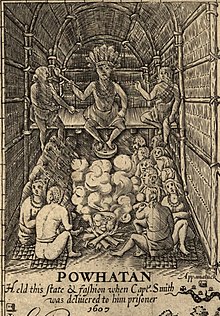
Longhouses were a style of residential dwelling built by Native American First Nation peoples in various parts of North America. Sometimes separate longhouses were built for community meetings.


Longhouses were a style of residential dwelling built by Native American First Nation peoples in various parts of North America. Sometimes separate longhouses were built for community meetings.
The Iroquois (Haudenosaunee or "People of the Longhouses") who resided in the Northeastern United States as well as Eastern Canada (Ontario and Quebec) built and inhabited longhouses. These were sometimes more than 75 m (246 ft) in length but generally around 5 to 7 m (16 to 23 ft) wide. Scholars believe walls were made of sharpened and fire-hardened poles (up to 1,000 saplings for a 50 m (160 ft) house) driven close together into the ground. Strips of bark were woven horizontally through the lines of poles to form more or less weatherproof walls. Poles were set in the ground and braced by horizontal poles along the walls. The roof is made by bending a series of poles, resulting in an arc-shaped roof. This was covered with leaves and grasses. The frame is covered by bark that is sewn in place and layered as shingles, and reinforced by light swag.

Doors were constructed at both ends and were covered with an animal hide to preserve interior warmth. Especially long longhouses had doors in the sidewalls as well. Longhouses featured fireplaces in the center for warmth. Holes were made above the hearth to let out smoke, but such smoke holes also let in rain and snow. Ventilation openings, later singly dubbed as a smoke pipe, were positioned at intervals, possibly totalling five to six along the roofing of the longhouse. Missionaries who visited these longhouses often wrote about their dark interiors.
On average a typical longhouse was about 80 by 18 by 18 ft (24.4 by 5.5 by 5.5 m) and was meant to house up to twenty or more families, most of whom were matrilineally related. The people had a matrilineal kinship system, with property and inheritance passed through the maternal line. Children were born into the mother's clan.
Protective palisades were built around the dwellings; these stood 14 to 16 ft (4.3 to 4.9 m) high, keeping the longhouse village safe.
Tribes or ethnic groups in northeast North America, south and east of Lake Ontario and Lake Erie, which had traditions of building longhouses include the Five Nations of the Iroquois Confederacy (Haudenosaunee): Seneca, Cayuga, Onondaga, Oneida and Mohawk. The Iroquoian Wyandot (also called Huron) and Erie also built longhouses, as did the Algonquian Lenni Lenape, who lived from western New England in Connecticut, along the lower Hudson River, and along the Delaware River and both sides of the Delaware Bay. The Pamunkey of the Algonquian-speaking Powhatan Confederacy in Virginia also built longhouses.
Although the Shawnee were not known to build longhouses, colonist Christopher Gist describes how, during his visit to Lower Shawneetown in January 1751, he and Andrew Montour addressed a meeting of village leaders in a "Kind of State-House of about 90 Feet long, with a light Cover of Bark in which they hold their Councils." [1]


The indigenous peoples of the Pacific Northwest of North America also built a form of longhouse. Theirs were built with logs or split-log frame, and covered with split log planks, and sometimes an additional bark cover. Cedar is the preferred lumber. The wealthy built extraordinarily large longhouses. The Suquamish Old Man House, at what became the Port Madison Squamish Reservation, was 500×40–60 ft (152×12–18 m), c. 1850. [2] [3]
Usually one doorway faces the shore. Each longhouse contains a number of booths along both sides of the central hallway, separated by wooden containers (akin to modern drawers). Each booth has its own individual hearth and fire. Usually an extended family occupied one longhouse, and cooperated in obtaining food, building canoes, and other daily tasks. The gambrel roof was unique to Puget Sound Coast Salish. [2] The front is often very elaborately decorated with an integrated mural of numerous drawings of faces and heraldic crest icons of raven, bear, whale, etc. A totem pole often was erected outside the longhouse. The style varies greatly, and sometimes it became part of the entrance way.
Tribes or ethnic groups along the North American Pacific coast with some sort of longhouse building traditions include the Haida, Tsimshian, Tlingit, Makah, Clatsop, Coast Salish and Multnomah.
From beneath mud flows dating back to about 1700, archaeologists have recovered timbers and planks. In the part of one house where a woodworker lived, tools were found and also tools in all stages of manufacture. There were even wood chips. Where a whaler lived, there lay harpoons and also a wall screen carved with a whale. Benches and looms were inlaid with shell, and there were other indications of wealth.
A single house had five separate living areas centered on cooking hearths; each had artifacts that revealed aspects of the former occupants' lives. More bows and arrows were found at one living area than any of the others, an indication that hunters lived there. Another had more fishing gear than other subsistence equipment, and at another, more harpoon equipment. Some had everyday work gear, and few elaborately ornamented things. The whaler's corner was just the opposite.
The houses were built so that planks on the walls and roofs could be taken off and used at other places, as the people moved seasonally. Paired uprights supported rafters, which, in turn, held roof planks that overlapped like tiles. Wall planks were lashed between sets of poles. The position of these poles depended on the lengths of the boards they held, and they were evidently set and reset through the years the houses were occupied. Walls met at the corners by simply butting together. They stayed structurally independent, allowing for easy dismantling. There were no windows. Light and ventilation came by shifting the position of roof planks, which were simply weighted with rocks, not fastened in position.
Benches raised above the floor on stakes provided the main furniture of the houses. They were set near the walls. Cuts and puncture marks indicated they served as work platforms; mats rolled out onto them tie with elders' memories of such benches used as beds.
Storage was concentrated behind the benches, along the walls and in corners between benches. These locations within the houses have yielded the most artifacts. The rafters must have also provided storage, but the mudflow carried away this part of the houses.


The Wyandot people are Indigenous peoples of the Northeastern Woodlands of North America, and speakers of an Iroquoian language. In the US the Wyandotte Nation is a federally recognized tribe headquartered in Wyandotte, Oklahoma. In Canada, the Wyandot sister nation is known as Huron-Wendat Nation, and they have two First Nations reserves at Wendake, Quebec.

The Mohawk people are the most easterly section of the Haudenosaunee, or Iroquois Confederacy. They are an Iroquoian-speaking Indigenous people of North America, with communities in southeastern Canada and northern New York State, primarily around Lake Ontario and the St. Lawrence River. As one of the five original members of the Iroquois League, the Kanienʼkehá꞉ka are known as the Keepers of the Eastern Door – the traditional guardians of the Iroquois Confederation against invasions from the east.
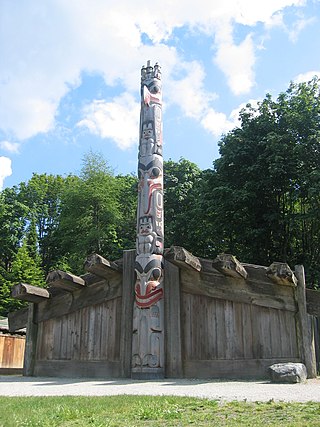
A longhouse or long house is a type of long, proportionately narrow, single-room building for communal dwelling. It has been built in various parts of the world including Asia, Europe, and North America.

The Dartmoor longhouse is a type of traditional stone-built home, typically found on the high ground of Dartmoor, in Devon, England and belonging to a wider tradition of combining human residences with those of livestock under a single roof specific to western Britain; Wales, Cornwall and Devon, where they are more usually referred to simply as longhouses and in general housebarns.

A dugout or dug-out, also known as a pit-house or earth lodge, is a shelter for humans or domesticated animals and livestock based on a hole or depression dug into the ground. Dugouts can be fully recessed into the earth, with a flat roof covered by ground, or dug into a hillside. They can also be semi-recessed, with a constructed wood or sod roof standing out. These structures are one of the most ancient types of human housing known to archaeologists, and the same methods have evolved into modern "earth shelter" technology.
The Huron-Wendat Nation is an Iroquoian-speaking nation that was established in the 17th century. In the French language, used by most members of the First Nation, they are known as the Nation Huronne-Wendat. The French gave the nickname “Huron” to the Wendat, meaning “boar’s head” because of the hairstyle of Huron men. Wendat (Quendat) was their confederacy name, meaning “people of the island” or "dwellers on a peninsula."
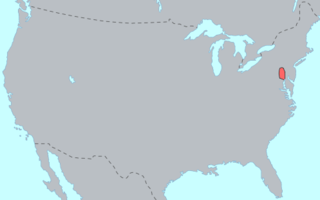
The Susquehannock people, also called the Conestoga by some English settlers or Andastes were Iroquoian Native Americans who lived in areas adjacent to the Susquehanna River and its tributaries, ranging from its upper reaches in the southern part of what is now New York, through eastern and central Pennsylvania west of the Poconos and the upper Delaware River, with lands extending beyond the mouth of the Susquehanna in Maryland along the west bank of the Potomac at the north end of the Chesapeake Bay.

A wigwam, wickiup, wetu (Wampanoag), or wiigiwaam is a semi-permanent domed dwelling formerly used by certain Native American tribes and First Nations people and still used for ceremonial events. The term wickiup is generally used to refer to these kinds of dwellings in the Southwestern United States and Western United States and Northwest Alberta, Canada, while wigwam is usually applied to these structures in the Northeastern United States as well as Ontario and Quebec in central Canada. The names can refer to many distinct types of Indigenous structures regardless of location or cultural group. The wigwam is not to be confused with the Native Plains tipi, which has a different construction, structure, and use.
The Great Peacemaker, sometimes referred to as Deganawida or Tekanawí:ta was by tradition, along with Jigonhsasee and Hiawatha, the founder of the Haudenosaunee, commonly called the Iroquois Confederacy. This is a political and cultural union of six Iroquoian-speaking Native American tribes residing in the present-day state of New York, northern Pennsylvania, and the eastern portion of the province of Ontario, Canada. The traditional stories and legends about Skennenrahawi do not provide a specific date or year for when he lived but Haudenosaunee tradition indicates 200AD - 300AD in lodge teachings. However, it is generally believed that he lived several centuries ago, likely in the pre-contact era of North American history when the Haudenosaunee (Iroquois) Confederacy was formed. The exact dates and historical details of this time period are often the subjects of ongoing research and debate among scholars and historians.

Ganondagan State Historic Site, also known as Boughton Hill, is a Native American historic site in Ontario County, New York in the United States. Location of the largest Seneca village of the 17th century, the site is in the present-day Town of Victor, southwest of the Village of Victor. The village was also referred to in various spellings as Gannagaro, Canagora, Gandagora, Gandagaro and Gannontaa.
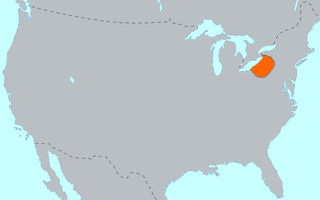
The Erie people were Indigenous people historically living on the south shore of Lake Erie. An Iroquoian group, they lived in what is now western New York, northwestern Pennsylvania, and northern Ohio before 1658. Their nation was decimated in the mid-17th century by five years of prolonged warfare with the powerful neighboring Iroquois for helping the Huron in the Beaver Wars for control of the fur trade.
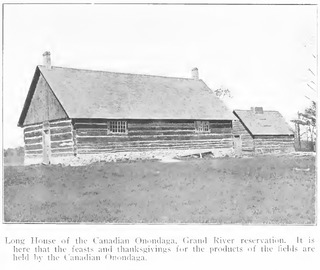
The Longhouse Religion is the popular name of the religious movement also known as The Code of Handsome Lake or Gaihwi:io, founded in 1799 by the Seneca prophet Handsome Lake (Sganyodaiyoˀ). This movement combines and reinterprets elements of traditional Iroquois religious beliefs with elements adopted from Christianity, primarily from the Quakers. Anthropologist Anthony F. C. Wallace reported that the Gaihwi:io had about 5,000 practicing members as of 1969. Originally the Gaihwi:io was known as the "new religion" in opposition to the prevailing animistic beliefs, but has since become known as the "old religion" in opposition to Christianity.
The St. Lawrence Iroquoians were an Iroquoian Indigenous people who existed from the 14th century to about 1580. They concentrated along the shores of the St. Lawrence River in present-day Quebec and Ontario, Canada, and in the American states of New York and northernmost Vermont. They spoke Laurentian languages, a branch of the Iroquoian family.

A smoke hole is a hole in a roof for the smoke from a fire to vent. Before the invention of the smoke hood or chimney, many dwellings had smoke holes to allow the smoke from the hearth to escape. Pre-modern English homes with unglazed windows or thatch roofs required no special vent for smoke. These structures typically had only one story for living spaces, and inhabitants made do with a band of relatively clear air near the ground.
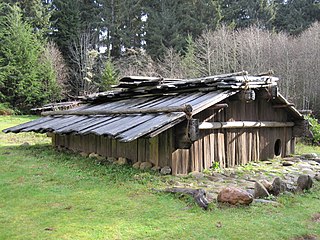
A plank house is a type of house constructed by indigenous peoples of the Pacific Northwest, typically using cedar planks.
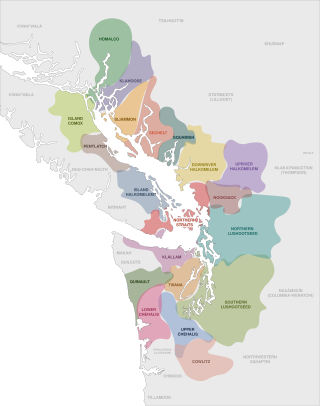
The Coast Salish is a group of ethnically and linguistically related Indigenous peoples of the Pacific Northwest Coast, living in the Canadian province of British Columbia and the U.S. states of Washington and Oregon. They speak one of the Coast Salish languages. The Nuxalk nation are usually included in the group, although their language is more closely related to Interior Salish languages.
Squamish culture is the customs, arts, music, lifestyle, food, painting and sculpture, moral systems and social institutions of the Squamish indigenous people, located in the southwestern part of British Columbia, Canada. They refer to themselves as Sḵwx̱wú7mesh. They are a part of the Coast Salish cultural group. Their culture and social life is based on the abundant natural resource of the Pacific Northwest coast, rich in cedar trees, salmon, and other resources. They have complex kinship ties that connect their social life and cultural events to different families and neighboring nations.

The Iroquois, officially the Haudenosaunee, are an Iroquoian-speaking confederacy of First Nations peoples in northeast North America and Upstate New York. They were known during the colonial years to the French as the Iroquois League, and later as the Iroquois Confederacy. The English called them the Five Nations, comprising the Mohawk, Oneida, Onondaga, Cayuga, and Seneca. After 1722, the Iroquoian-speaking Tuscarora from the southeast were accepted into the confederacy, which became known as the Six Nations.

Jigonhsasee was an Iroquoian woman considered to be a co-founder, along with the Great Peacemaker and Hiawatha, of the Haudenosaunee (Iroquois) Confederacy sometime between AD 1142 and 1450; others place it closer to 1570–1600. Jigonhsasee became known as the Mother of Nations among the Iroquois.
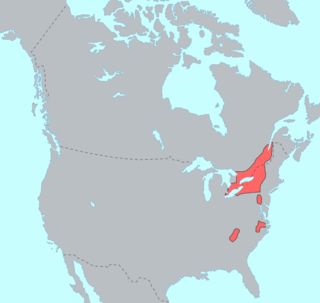
The Iroquoian peoples are an ethnolinguistic group of peoples from eastern North America. Their traditional territories, often referred to by scholars as Iroquoia, stretch from the mouth of the St. Lawrence River in the north, to modern-day North Carolina in the south.